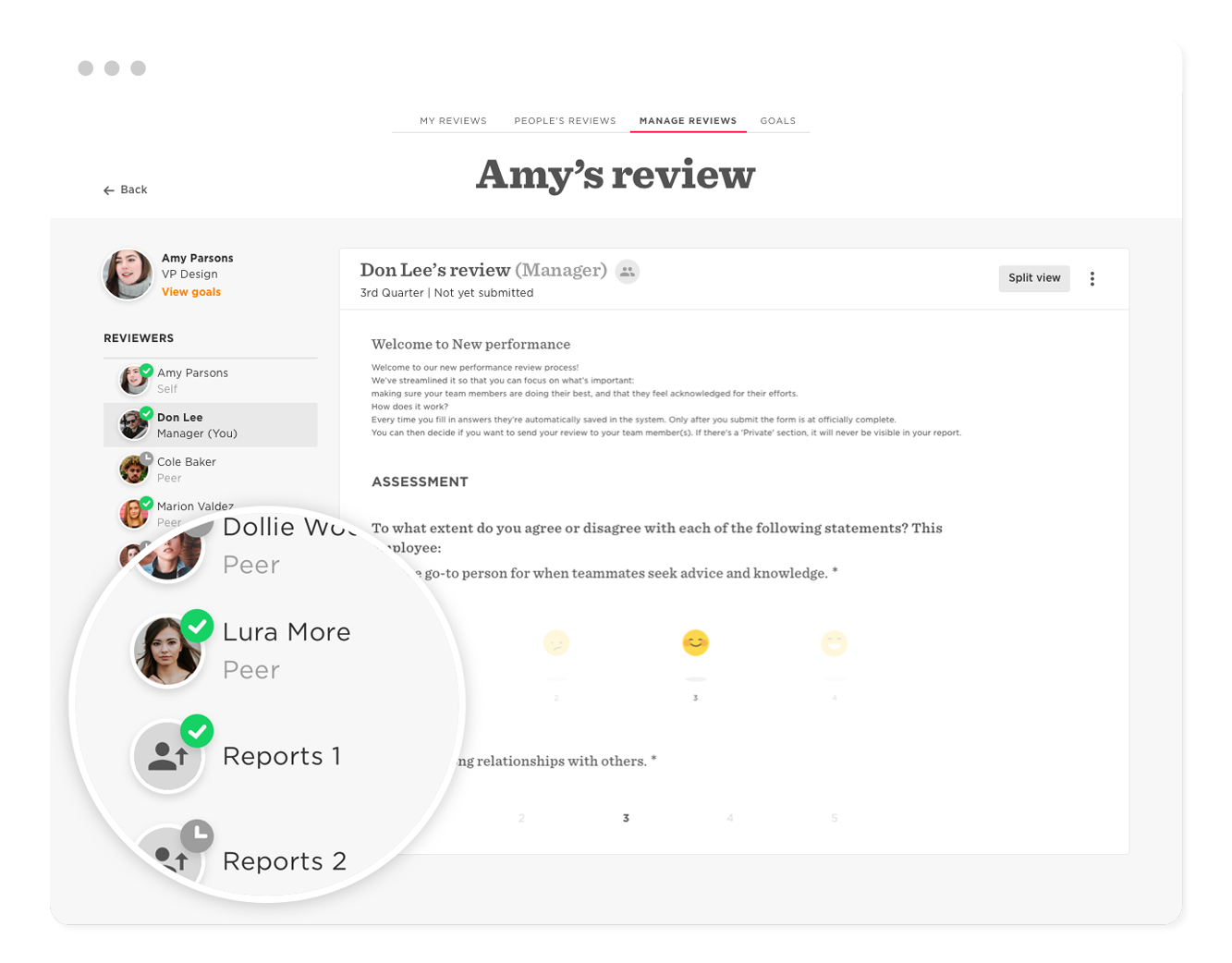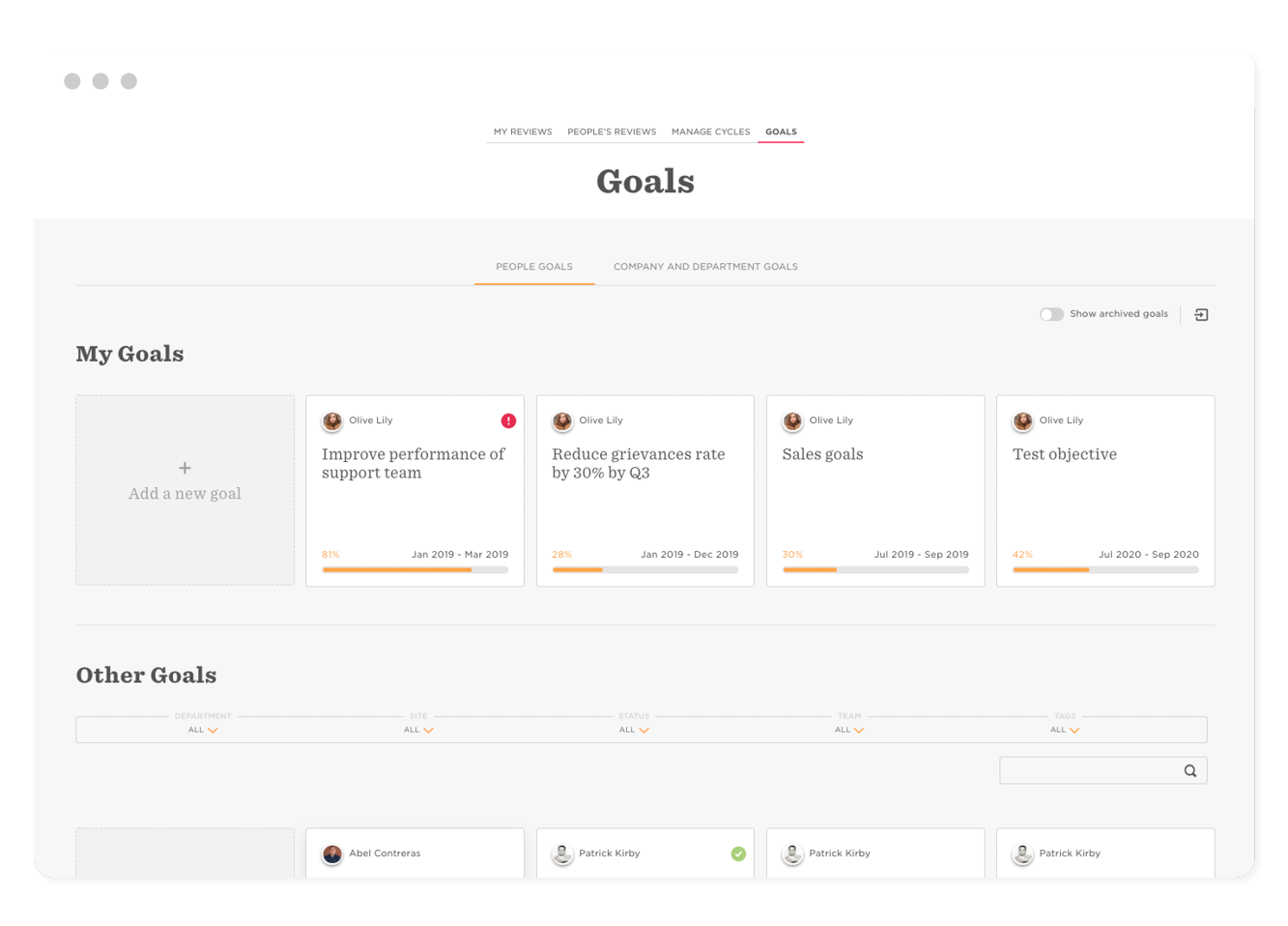Introduction
When many people think about traditional performance reviews they imagine the much-dreaded annual review, but limiting employee reviews to a big annual appraisal is falling out of favor. The traditional structure has been found to limit collaboration and innovation and doesn’t foster employee engagement, growth, or learning. But this model is changing. A growing number of global companies are shifting to a performance management strategy that is continual and focuses on individual development and cross-organizational alignment instead of a zero-sum annual model.
Performance management can improve employee engagement—and happier more engaged employees are more productive employees. While disengaged workers are estimated to cost the American economy $300 billion every year, organizations with higher engagement enjoy nearly a 30% growth in earnings per share. What this means is that performance management, when done right, can help employees become more productive, develop new skills, and take an active part in promoting organizational goals. An effective performance management strategy can also help organizations improve processes, systems, and procedures towards greater efficiency and growth.
What is performance management?
Performance management is an integrated approach to helping an organization achieve its aims and objectives by monitoring and improving the performance of people, teams, and the organization as a whole.
Armstrong and Baron define performance management as “a process which contributes to the effective management of individuals and teams in order to achieve high levels of organizational performance. As such, it establishes a shared understanding about what is to be achieved and an approach to leading and developing people which will ensure that it is achieved”. They stress that it is “a strategy which relates to every activity of the organization set in the context of its human resource policies, culture, style, and communications systems.”

Performance appraisals
While leaving a full year of employee review to one big scary meeting is not an effective way to manage performance, performance appraisals are still an important part of an ongoing performance management strategy.
Appraisals evaluate an employee’s job performance and overall contribution to the company towards improving productivity. Performance appraisals also provide feedback on how to improve an organization’s processes towards improved employee retention, satisfaction—and, subsequently, performance. Performance appraisals generally occur between employees and their direct managers. To keep these meetings constructive, the focus should remain on the shared responsibility of both managers and employees to promote organizational goals.
If employees aren’t involved in and informed about the review process, appraisals can seem intimidating. But if performance appraisals are performed in the context of an ongoing performance management process, they become an opportunity for positive growth and cooperation.
Benefits of performance management
Moving past the intimidating once a year performance review model of employee development, performance management is an ongoing, constructive, and collaborative process. Rather than calling people in for an annual review, performance management encourages shared strategies between management and employees to accomplish organizational goals.
Research has shown that performance management can yield significant positive results. A recent Gallup poll found that more than half of American employees are disengaged from their work, leading to lower productivity and increased turnover. By fostering deeper employee engagement with organizational goals through performance management, studies have shown companies can boost operating margins by up to three times compared to counterparts with lower levels of engagement and enjoy up to 22% greater profitability.
But implementing an effective performance management strategy can be a challenge. In one study, only 8% of companies surveyed reported that their process drives high levels of value, while 58% said it is not an effective use of time. Applying a framework that encourages dialogue, coaching, and continuous feedback takes some consideration—and the right tech—but once in place, organizations will gain the tools to build a better, stronger workplace.
To be effective, performance management must be conducted in the context of the organization’s overall strategic plan, with the aim of generating the momentum required to achieve corporate goals. This requires first designing a performance management framework.

Creating a performance management framework


Performance management should always be a shared process between HR, employees, and managers. Getting all of the stakeholders aligned and informed about their responsibilities will keep performance management running smoothly.
1. Managers are responsible for reinforcing performance by providing clear direction and guidance. Communication with employees is vital to maintaining an effective ongoing performance management process.
2. Employees are the most important resource of any successful company. In a company with a healthy culture and comprehensive performance management protocol, employees are responsible for achieving individual goals, tracking progress, and communicating with team members and managers.
3. HR provides the best practices and processes for performance management across the entire organization. Whether developing processes for executives, managers, or individual contributors, HR is responsible for designing and implementing training programs that align with the organization’s performance management framework.
When collaborating to develop an organization’s performance management framework, work from what you already have towards where you want to be.
4. Understanding and evaluating current practices to identify areas requiring improvement. The self-auditing process is vital to creating an effective performance management system. Find out what your people need to stay on target by pinpointing any pain points and finding concrete solutions.
5. Fostering cross-organizational alignment on targets and objectives to meet organizational goals, and developing these larger goals into actionable, measurable individual goals. Every employee is vital to the success of a company and every project moves the dial, so it’s important to make sure everyone is going in the same direction.
6. Running training and activities to develop capabilities and achieve the desired progress. This will include training managers in implementing performance management and communicating with employees. By empowering managers to set clear objectives, evaluate performance, and offer feedback in an effective manner, organizations can benefit from up to 15% greater productivity.
7. Measuring and monitoring changes, improvements, and progress towards goals will provide important insight to improve your processes and boost productivity. Using tech-enabled solutions to analyze goal attainment, deadlines, and resource allocation can streamline performance management and save valuable time.
8. Reviewing progress, renewing goals, and staying responsive to the data means being agile to necessary changes. If employees aren’t receiving consistent enough feedback and lags are appearing, you may need to add more frequent reviews or revisit how individual goals and directives are communicated.
Performance management principles
The following principles should guide the development of your performance management framework. Once a general framework is developed, these principles will inform project planning at every level. A firm set of principles provides a foundation for employee-centered and growth-oriented performance management:
1. Leadership
- Empower organizational leadership to provide clarity and example from the top
- Invest in training managers to give them the skills they need to engage their teams
- Involve managers in developing performance management plans
2. Open communication
- Make performance management a continuing and collaborative process between managers and employees
- Managers should be trained in how to give constructive feedback and set clear expectations about performance
- Encourage an open-door policy between managers and employees. HR should also be available to employees requesting guidance or support
3. Agility
- Be open to adjusting the performance management policy as needed based on metrics and feedback
- Empower managers and teams to discuss results and pivot when required
- Risk-taking should be encouraged
4. Promote employee engagement
- Give your people the ability to add value and actively participate in performance management with regular strategy meetings, check-ins, and training
- Adapt the performance management process for different segments and departments while keeping individual objectives aligned with organizational goals
- Recognize and celebrate successes with formal and informal shoutouts recognizing individual or team achievements
5. Keep it positive and constructive
- Performance management should focus on professional development
- Address underperformance separately from ongoing performance management
- Harness technology to implement and monitor your performance management strategy, but don’t forget to keep it human with regular face-to-face (IRL or by video) check-ins
6. Addressing under-performance
Sometimes an employee is simply not meeting targets and their underperformance is not linked to failures in management. In such cases, it is important to have a process for corrective action in place that is respectful of the employee but prioritizes organizational continuity.
- Call the employee in for a performance appraisal. If performance management has been ongoing, the employee will not be surprised that they haven’t achieved what was expected
- Give the employee a corrective performance plan with clear expectations for improvement, including a timeline and clear objectives
- Offer support to achieve these improvements; consider offering additional training or mentorship, and take care to maintain ongoing communication with the employee to swiftly address any pain points
- If the objectives outlined are not attained, and management and HR agree that efforts to assist the employee aren’t sufficient, consider beginning the parting-ways process
Performance management strategy
With the principles of performance management in place and with the collaboration of managers, HR, and employees, the next step is outlining a concrete strategy on how to utilize performance management to actualize employee potential and promote organizational success.
1. Align objectives with organizational strategy
The purpose, values, and goals of each unit or department of the organization should support or relate to the purpose, values, and goals of the organization. This will create a situation where each time that a departmental goal is achieved, the organization moves forward.
Setting periodic departmental strategy meetings will foster alignment by giving managers, department heads, and other stakeholders the opportunity to sync up and evaluate progress. Managers can communicate any insights or changes to their teams, ensuring that every member of an organization is acting in tandem.
2. Set standards, criteria, and indicators
Transparent management is vital to the credibility of the performance management process. Setting clear standards and indicators enables every individual to understand their role in the organization. Individual deliverables should be designed according to the SMART acronym: Specific, Measurable, Achievable, Realistic, and Time-bound.
3. Choose evaluation methods
There are a variety of different performance management methods to choose from, depending on the industry or department
Management by Objective (MBO)
In this method, measurable goals are set collaboratively for the organization, various departments, and each individual member.Employees are evaluated annually based on how well they have achieved the results specified by the goals. MBO is a good method for evaluation in nonroutine jobs, such as those of managers or project leaders who cascade organizational goals down to employees, and fosters productivity by providing specific, detailed targets.
Some examples of objectives include:
- Increase revenue by 15% in Q3
- Generate 500 new MQLs per month
- Increase employee retention by 20%
- Decrease client onboarding time by 50%
Critical incident method
By describing specific events (or incidents) where the employee performed well or in a way that needs improvement, the critical incident method (CIT) puts performance in context and illustrates how the individual understands their choices.
For example, a manager may ask an employee about a specific project that required significant retooling.By explaining how they proceeded and what influence this had on the outcome, managers are able to assess positive or negative performance.
Checklist method
This method consists of a series of statements that the evaluator responds “yes” or “no” to regarding the employee’s behavior or performance.
A checklist could look like this:
- The employee is punctual
- The employee is courteous and helpful to his/her team members
- The employee is engaged in his/her work
- The employee is reliable
- The employee works consistently towards assigned goals
- The employee performs tasks correctly
360-degree performance appraisal
This method involves collecting information about the individual’s performance from supervisors, colleagues, or employees they manage. This group review focuses on employee development, getting feedback from a range of sources to inform performance management.
Relevant stakeholders will be asked anonymously about the individual’s work-related behavior and about the impact this has on operations. Appraisals consist of online forms that give respondents the opportunity to provide feedback about the subject’s competencies. This can be done using any rating format, for example, a Likert scale:
On a scale of one to ten, please rate [employee’s] proficiency in leadership:
- Motivates others towards their goals
- Handles conflict in an appropriate manner
- Is an adept problem solver
Competency-based
Instead of measuring performance according to measurable outcomes, specific tasks, or work- related behaviors, this project management method focuses on performance as measured against specific competencies assigned to each individual position.
Competencies can be broken down into core competencies and behavior indicating the individual possesses these competencies. For example, “empowering others” is the core competency your organization and the observable behaviors are:
- Lets people make decisions regarding their work
- Encourages others to achieve individual and group goals
- Provides positive reinforcement
- Avoids micromanaging and encourages collaborative problem solving
Graphic rating scale (GRS) appraisals
GRS lists several factors, including behaviors and characteristics that are used to rate the individuals according to gradations (for example unsatisfactory, satisfactory, excellent).
Some characteristics that might be evaluated are:
- Attendance
- Work quality
- Teamwork
- Dependability
4. Build performance management into the business planning cycle
As performance management deals with personal objectives that in turn feed into the organization’s strategy for achieving its corporate objectives, performance management should be an integral part of the business planning cycle. So, make room for employee development, manager training, periodic reviews, and other performance management activities.
5. Ensure clear communication
Successful performance management depends on the engagement and involvement of all employees. Be clear about what your performance management process is seeking to achieve, how it will operate, how objectives will be set, what criteria will be used for evaluating performance, and whether compensation is involved. A culture of open communication will enable management to stay agile and productive.
6. Monitor and review
Unless you keep track of what your performance management strategy is achieving, it won’t be effective. Using an online performance management platform will give you control over performance data, metrics, and employee feedback. Review this information and share insights across your organization to celebrate achievements—or leverage this knowledge to swiftly implement any necessary changes so that your organization can keep operations on track.
Performance appraisal checklist for managers
When meeting with an employee during regular performance appraisal meetings, it is important to ensure that these focus on employee development and how management and teams can work together in achieving organizational goals. When sitting down with employees, managers should address the following:
- Clarify organizational and individual goals and objectives
- Outline talking points of the appraisal meeting
- Discuss accomplishments
- Discuss possible areas of improvement
- Review previous goals
- Determine future goals in collaboration with employee
- Offer opportunities for career development
- Give the employee time to bring up any questions and concerns
Performance appraisal prep for employees
Before walking into a performance appraisal, employees should be given the opportunity to self-assess their performance. Self-assessment should furthermore be a focus of any performance management system, regardless of the chosen evaluation method. This is a chance for employees to consider their strengths and weaknesses and gain insight into how they can improve.
Self-evaluation is also useful for managers. By supporting communication, managers can get feedback on what motivates the employee and where their talents can best support organizational goals.
Here are some questions to guide employee self-assessment:
1. How is my current performance?
This means considering the expectations of the job and how you are delivering on these expectations presently. A SWOT analysis can be useful but isn’t mandatory.
Strengths, Weaknesses, Opportunities, and Threats. Breaking things down and getting them in writing is a great way to understand what you need to do to achieve individual goals and grow in the organization.
2. Where do I want to be?
This is where you think about what you would like to be doing better or what kind of career development would motivate you. Maybe this means learning a new skill or improving on current tasks, or maybe it’s a promotion, but make sure that whatever your goals are they are concrete and, if relevant, measurable.
3. What criteria measure my success?
You likely already have a set of objectives and indicators attached to your role in the organization. Consider whether these are contributing to your continued success and providing insight into your progress. While some criteria are more obvious and productivity based, others may evaluate soft skills that are not quantifiable.
4. What can I improve?
Self-evaluating your performance in relation to organizational, departmental, and individual goals should give you a clear direction for how to improve. Outline specific areas where you could improve and clear steps that you foresee getting you there.
Recommended For Further Reading
The power of tech for performance management
Using an advanced performance management system has a range of benefits:
- Provide meaningful performance results
- Aid in the growth of training and career development programs
- Help set expectations
- Monitor performance
- Assist in rewarding top performers
- Ensure efficiency in achieving company goals
- Drive more feedback from employees and encourage positive attitudes toward performance reviews
The digitization of performance management provides more precise data and positively influences management processes and strategic development. Technology-enabled performance management tools simplify the evaluation process and promote employee engagement for amplified organizational success.
Conclusion

An effective performance management process starts with a self-audit, proceeds with principles, and delivers impact with strategy and implementation. Done right, performance management processes convey a shared understanding of company goals and a shared approach to achieving these goals.
Leading and developing your people with tech-enhanced performance management processes will improve employee engagement, propel productivity, and keep the entire organization aligned in its mission.
